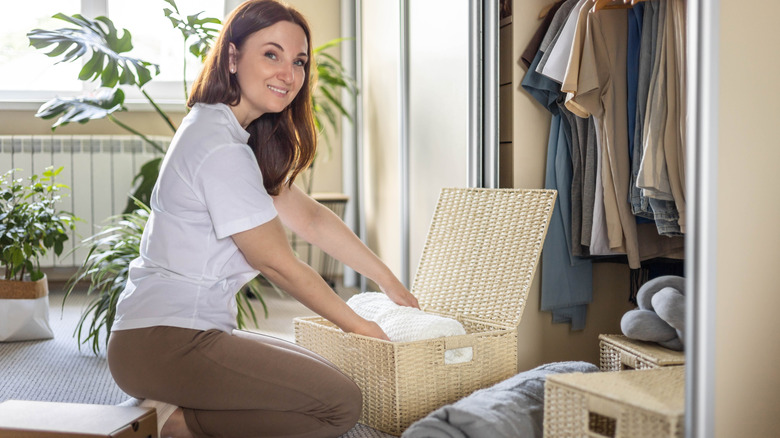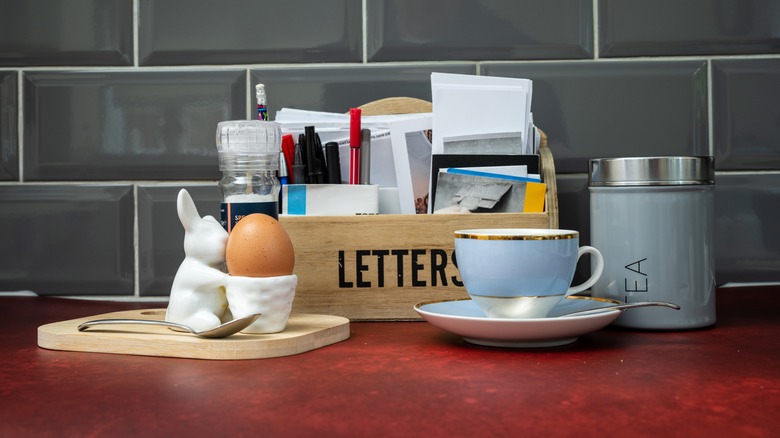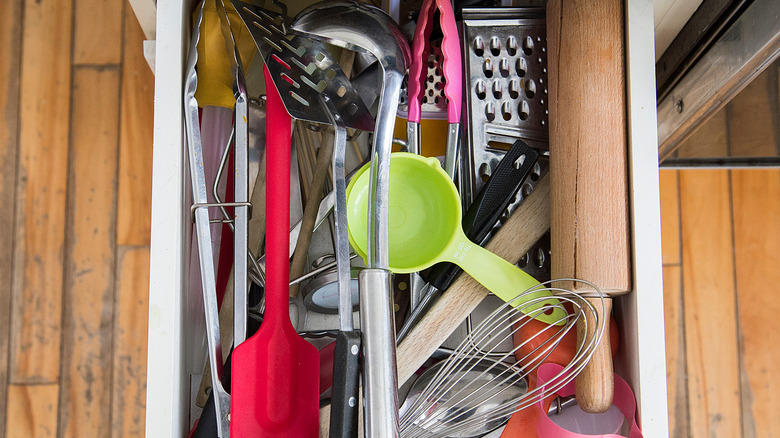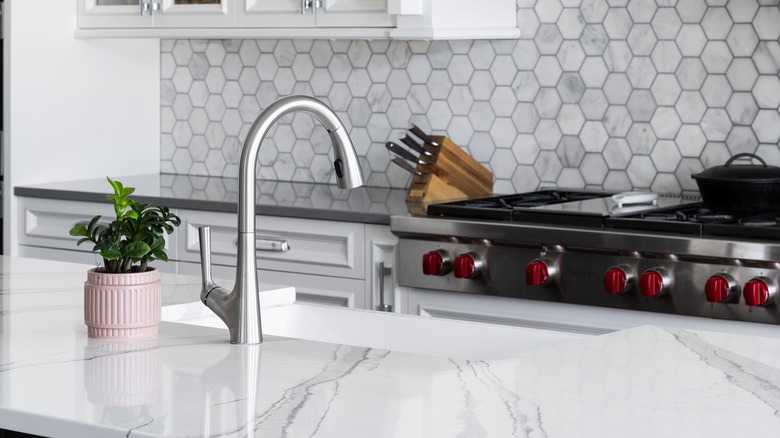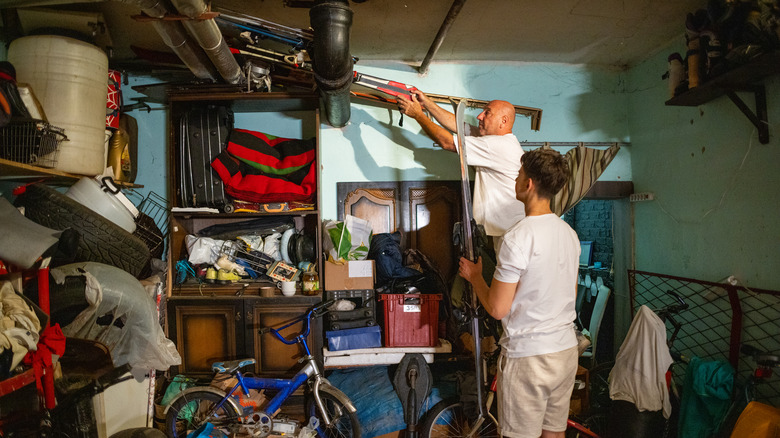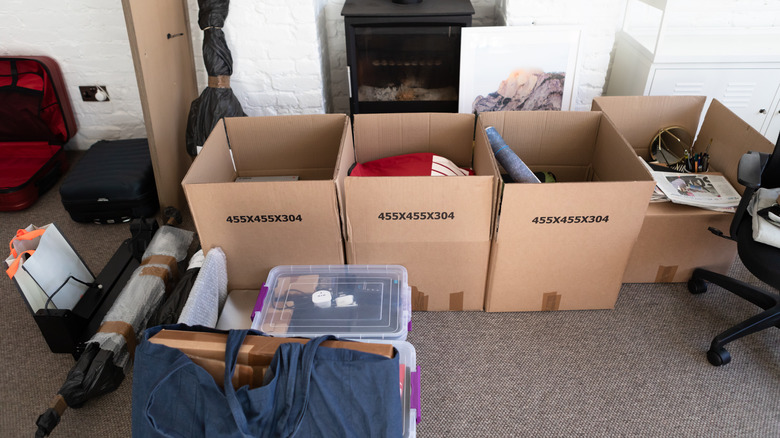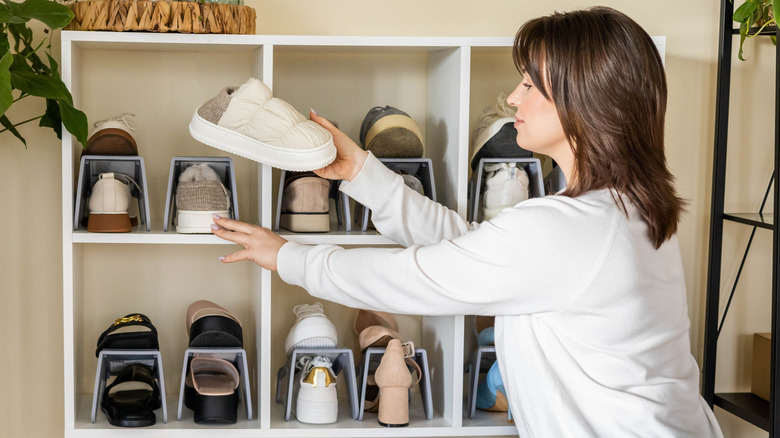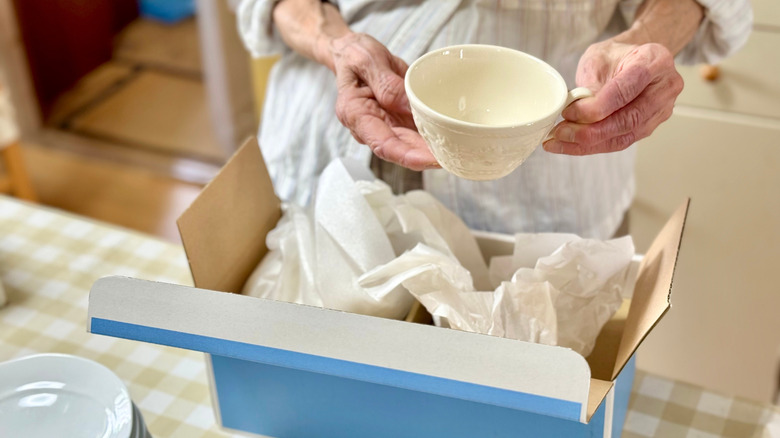12 Strategies That Work Best For Decluttering Your Home
We may receive a commission on purchases made from links.
It's probably safe to say that no one really enjoys living in a cluttered home. However, it is also true that most of us have more clutter around the house than we'd like to admit. Decluttering isn't always an easy task. It can be time-consuming and can force you to make difficult decisions about what you should be getting rid of. However, unpleasant as it is, clearing away all those excess items is important.
Beyond being able to enjoy cleared surfaces and drawers that are no longer stuffed to the brim, clearing out clutter can also help improve your mental health. You'll be able to focus more on what you need to get done without such a visually distracting environment. Clearing away the clutter can also help lower one's stress levels and give their self-esteem a boost. Fortunately, this task doesn't have to be as difficult as you might be dreading. With the right strategy, you can conquer the chaos and take back control over your space. Because everyone is different and what works for one person might not work for another, we've pulled together a list of several strategies to help you declutter your home.
Start with an easy area that will help you gain momentum
As you're thinking about the task in front of you, remember that you don't have to start with figuring out how to get rid of that sentimental clutter. In fact, starting with a more challenging and mentally-taxing task like that probably isn't a good idea. You're likely to get overwhelmed trying to make tough decisions and completely lose your motivation to declutter. Instead, start with an "easy" task that won't require a lot of time or mental effort. Doing so will help you achieve success more quickly, which should make you feel empowered to move on to another room in the house.
So, what could be the best spot to start? Well, it will depend, of course, on which areas in your home need attention. But, a few areas that are likely to be a bit less involved might include the table where your mail piles up, the kitchen island, or a bedroom dresser. These are all relatively small surfaces, so even if they are very cluttered, there can only be so many physical items to deal with. Moreover, these surfaces are also in more prominent areas, so you'll continue to enjoy the fruits of your labor every time you walk by them.
See how much you can accomplish by dedicating just five minutes per day
Part of the reason so many of us don't deal with all the piles and stuffed drawers in our homes is because we feel intimidated and overwhelmed just thinking about trying to declutter everything. We picture spending hours — or even days — on end going through pile after pile and drawer after drawer just to make a small dent. Flipping the switch on this mindset and letting yourself view decluttering as an ongoing process can help you achieve a lot more than you would think. Dedicating a much more manageable five minutes per day to take on one task can make a difference. If you do this every day for a week, you'll have spent 35 minutes, which feels a lot more significant.
Five minutes is not an overwhelming amount of time.There are several quick and easy decluttering tasks that will take only a few minutes of your time. Perhaps you focus on one shelf in the refrigerator or one drawer in your bathroom vanity. Clearing out that space can go a long way towards making the entire fridge or vanity feel less chaotic. And, the next day, you could move on to a different shelf or another drawer during your five-minute session.
Starting these five-minute decluttering sessions can also help you build your decluttering "muscle" and get you into the general habit of decluttering. The next thing you know, you might find yourself automatically doing a small decluttering task without even thinking about it. For example, while your mind may have once balked at the thought of organizing your spice rack, you could just start straightening it out and ditching anything that is expired while waiting for a pot of water to come to a boil.
Break large decluttering jobs into more manageable chunks
Is there one room or area in your home that has you completely overwhelmed? Maybe it's your walk-in closet that has piles of clothes (from who knows how many weeks ago) in the corners, shoes shoved on the shelves, hampers of linens that never got put away, and random items tossed wherever they'll fit. Or, perhaps it's the guest room that has become the collection space for anything you don't want to deal with right away when cleaning or getting ready for guests to come. When you're facing a really large decluttering task, one of the most helpful things you can do is to break it down into more manageable chunks. Also known as the soft decluttering technique, applying this strategy can help you feel a little less overwhelmed about everything that you'll need to do.
So, instead of facing that daunting closet all at once, section it off and work on one zone at a time. One day, you could tackle all the shelves (or even just a small portion of them); the next day you could work on decluttering your large collection of t-shirts; and the day after that you could go through all the pants that are hanging up. With just a few days of addressing smaller tasks, you'll have the whole space done and back to being functional.
Channel Marie Kondo
You've probably heard of Marie Kondo and know that she developed the KonMari Method that is supposed to help people clear out the clutter in their home. However, hearing about the strategy and knowing how to actually start Marie Kondo's organizing method are two separate things. So, here's a crash course on what the KonMari Method is, so you can decide if it is a good strategy for you. Kondo recommends evaluating each item in your home and only holding on to those that "spark joy." That means that if you have something, but don't use or enjoy it, you should let it go. Letting these unloved items go clears up more space for those you truly love. Not only can implementing this method help you create a clutter-free space, but it can also help you focus more on what you love, since it will be much more visible and accessible than before.
Unlike many other decluttering strategies that have you move through your home room by room, the KonMari Method is designed to focus on one category at a time. You should complete going through all of the items in that category, even if they are in different rooms in the home, before moving onto the next category. Kondo recommends working in the following order: clothing, books, documents and paperwork, miscellaneous gear and accessories, and things you're holding for sentimental purposes.
Give yourself a vision to keep going
It is often easier to work towards something when you know what the end goal is. With decluttering, you're obviously aiming for a neater and tidier space, but sometimes visualizing what that will actually look like can be challenging — especially if the piles have been around for a while. One thing you can do to keep yourself going is to get a set of before and after pictures for one area. Take a picture of one area that needs some real T.L.C. — perhaps it is a section of the countertop or the desk in your office. After taking the time to purge and organize, take an "after" photo.
Post these two photos together in a central location where you'll see them regularly, such as on the refrigerator or the bulletin board in your office. Being able to compare the before and after pictures to see what a difference your efforts made should give you some extra motivation to move onto the other areas of the home that also need your attention. You could even print out a few copies of the before and after pictures and post them in each room that you want to work in as a little extra boost.
Enlist help for physically or mentally challenging tasks
Decluttering doesn't have to be a solo task. In fact, you could really benefit from enlisting some help from a trusted friend or family member. Having someone else with you will give you an extra set of hands, which can come in handy if you need to move heavy items or take multiple trips up or down the stairs to put things away. However, even more than that, your friend can serve as a backstop to help you make the right decisions about what you should keep — and what you don't really need.
If you've been holding on to something for sentimental reasons, a friend might be able to assist you in deciding if it is really worth letting it take up the space. After a discussion, you might decide that the space is more valuable than the memory attached to the item and that simply taking a picture of it will be sufficient. Similarly, your friend could help you weed through your utensil drawer and guide you to realizing you don't really need five sets of serving tongs.
Try the four basket method
If you haven't heard of the four basket method and how it can help declutter and organize your home, then you've been missing out. Despite being a simple and straightforward technique, you'll be surprised by how much you're able to pare down what you own and make more space for what you actually need. As the name implies, you'll need four baskets (or boxes/bins) for each room/space you go through. Make quick labels for each container: keep, sell, donate, and trash.
Once you have the materials set up, you're ready to start decluttering. As you pick up an item, decide which category it belongs in, and place it in the correct basket. You might find it helpful to fully empty the room/closet that you are trying to organize. This gives you a blank canvas and lets you see how much room you truly have. Plus, it will also put everything into a central location, like a bed or a table, so you won't have to keep moving around to grab items and bring them to the right box. Once you've finished sorting everything out, take time to organize the keep bin and return things where they belong. Then, deal with the remaining three baskets promptly. Put the garbage in a trash bag (or recycle as appropriate), bring the clothes to a local donation center, and get the sell pile listed on an online marketplace or brought to a consignment store as soon as possible. You don't want to leave anything lying around for long; it will only add clutter to a new space in your home.
Ask yourself questions to make quick decisions
Making decisions about what to keep and what to let go of isn't always easy. What you don't want to do is get into a lengthy debate with yourself over the worthiness of keeping a particular item. This will significantly lengthen the overall process if you spend several minutes going back and forth over whether to keep one thing. You're also much more likely to lose your motivation to keep working if you've barely made a dent after 20 or 30 minutes.
Instead, keep yourself focused and moving along by having a set of questions ready to ask yourself any time you wonder whether you should be keeping something. Start by considering whether you actually like and will use something — don't hold on to a gift from a friend or family member if you know it will permanently reside in the closet. You can also ask yourself if you actually need the item. For example, even if you have 25 t-shirts that you actually like, you don't need that many. This would be a good opportunity to weed through the pile and declutter.
Set limits for what you'll let yourself keep
Before you begin decluttering, think about what you want the space to look like once you're finished. In order to be successful and accomplish that goal, you might need to let go of a fair number of things. One strategy that could help you avoid keeping more than you should is to place limits on yourself. Tell yourself that you can only keep what will fit on a given shelf in the closet, or in a drawer in the kitchen.
Begin by clearing everything off the shelf and moving it to a table, countertop, or bed. As you go through the pile, place the items that you want to keep back into the drawer or onto the shelf. If it becomes too full before you've finished decluttering, then you'll need to take a second pass and pick out a few more items that you really don't need to keep. By setting a limit at the beginning — and holding yourself to it throughout the process — you can make sure that you get rid of enough to gain back the space and organizational potential that you were looking for.
Put the 90/90 rule into practice
The 90/90 rule is another technique that can help you declutter your space. This "rule" encourages you to prioritize what to keep by focusing on whether an item is something you actually use. Each "90" in the title refers to a question you should ask yourself. The first question to ask is whether you have used a particular belonging over the past 90 days. If you answer "yes," then keeping the item would be reasonable. If you answer "no," then you'll need to move on to the second question, which is whether you will use the item in the next 90 days. If the answer to this question is also "no," then you likely won't have a use for it and should just let it go.
To put the 90/90 rule into practice, pick one area of your home you've been wanting to declutter. Make sure you have a box ready to collect all of the things you decide to let go of, and then get started. Pick up one item at a time, ask yourself the two questions, and decide what to do with it. If it is something you have used recently or will in the near future, return it to where it belongs. Alternatively, you could set up a table or use the bed to hold everything you decide to keep until you've finished going through the full space. This way, you'll be able to better organize everything at the end — and you might even find a few duplicates or very similar things you could part with.
Embark on a 30-day decluttering challenge
Maybe it's just us, but turning anything into a challenge automatically makes it sound more appealing and motivating. When you add in the support of a close friend or family member, you'll likely feel even more positive about your chances of success. For this reason, embarking on a 30-day decluttering challenge with a friend may be just what you need to finally get rid of all of those items you've been holding on to over the years.
There are different ways you and your friend might choose to structure your challenge. You could pick a different room/zone of the house to declutter each day. For example, one day might focus on the linen closet, one on the console table in the entry room, and one on the pantry. Another idea is to try the 30-day minimalism game. With this "game," you and your friend would each have to get rid of (trash, sell, or donate) a number of items to match the day of the month. So, on the fifth day of the month, you'd clear out five items, and on the 28th, you'd get rid of 28 things. When all is said and done, that means you will have gotten rid of an impressive 465 different items.
Set up a permanent donate bin in an easily accessible spot
Think about one area of your home you'd like to declutter. If you look back over the past weeks (or months), how many times have you looked at that area, seen something that needed to be put away or given away, and thought, "I'll do it later?" If you're like many people, the answer is probably several times. This "I can do it later" mindset can really interfere with you keeping your home clutter-free. Later either never comes, or, if it does, you're left with a huge mound of items, instead of just the original one or two things.
If you teach yourself to deal with clutter as it starts popping up, you can avoid facing a mountainous mess. One of the best ways to set yourself up for success and to ensure this method works seamlessly is to establish a "donate bin" in an easily accessible location. This will avoid the added friction of trying to track down an empty box, which could prevent you from following through with getting rid of an item, or result in the clutter pile simply shifting. Consider where you will put this bin, such as under the entryway console table, on a shelf in the garage, or in an extra cabinet in the kitchen. If the location is visible, opting for an attractive basket with a lid, such as the Honcesta Large Storage Basket With Lid, can prevent it from sticking out like a sore thumb against the rest of your home's decor.
